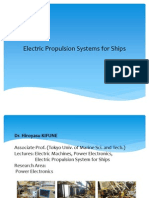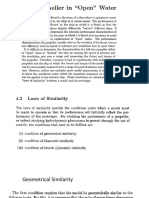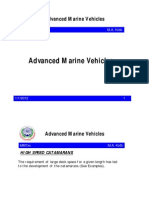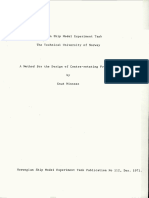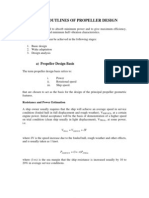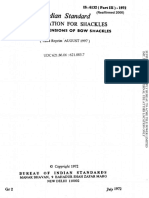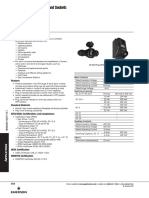Stapersma - Matching Propulsion Engine With Propulsor
Stapersma - Matching Propulsion Engine With Propulsor
Uploaded by
Tuan Truong MinhCopyright:
Available Formats
Stapersma - Matching Propulsion Engine With Propulsor
Stapersma - Matching Propulsion Engine With Propulsor
Uploaded by
Tuan Truong MinhOriginal Title
Copyright
Available Formats
Share this document
Did you find this document useful?
Is this content inappropriate?
Copyright:
Available Formats
Stapersma - Matching Propulsion Engine With Propulsor
Stapersma - Matching Propulsion Engine With Propulsor
Uploaded by
Tuan Truong MinhCopyright:
Available Formats
Matching propulsion engine with propulsor
Matching propulsion engine with propulsor
D Stapersma, Professor of Platform Systems, MSc, CEng, FIMarEST and HK Woud, Professor of Marine Engineering, MSc, FIMarEST, Delft University of Technology The basic matching problem of a propulsion engine to the propulsor is discussed and the influences which should be taken into account. The concepts of sea margin, engine margin and light running margin are handled and an indication of their values is given. The methods of calculation to evaluate design and off design conditions are discussed. Key words: matching, propulsion, engine, propulsor, sea margin, engine margin, light running margin, off-design conditions.
INTRODUCTION
ith the design of a ships propulsion system the correct matching of the prime mover(s) to the propulsor(s) and the ship is of great importance. In case the matching problem is not solved adequately the ship may have problems with regard to overloading prime movers, attainable speeds in off design conditions and an excessive fuel consumption. The propulsion system should not only operate satisfactorily in the design condition of the ship, but also in off-design situations, which the ship might encounter. Relevant offdesign situations may involve: variation of ship displacement, increased resistance due to seaway, the influence of the number of driving engines and active propulsors and of a shaft generator. The methods described in this paper are extensively discussed.1
AUTHORS BIOGRAPHIES J Klein Woud graduated in 1966 as a mechanical engineer at Delft University of Technology, with specialisation in internal combustion (diesel) engines.After military service in 1968 he joined Stork Werkspoor Diesel where he worked as application engineer for marine diesel engines. During 1970-1986 he worked for the naval design office, Nevesbu, The Hague, where he was involved with the design and engineering of frigates, submarines and patrol craft and their machinery systems. In October 1986 he was appointed professor of marine engineering at Delft University of Technology. He lectures on marine engineering systems and conducts research with regard to condition monitoring, maintenance and design techniques. During January 1995-June 1998 he was dean of the Faculty of Mechanical Engineering and Marine Technology. Since 2000 he is the Director of Education for Mechanical Engineering and Marine Technology. Douwe Stapersma graduated at Delft Technical University in the field of gas turbines, joined Nevesbu in 1973 and was involved in the design and engineering of the machinery installation of the Standard frigate. After that he coordinated the integration of the automatic propulsion control system for a class of export corvettes. From 1980 onward he was responsible for the design and engineering of the machinery installation of the Walrus class submarines and in particular the machinery automation. Then he was in charge of the design of the Moray class submarines in a joint project organisation with RDM. Nowadays the author is professor of Naval Engineering at the Royal Netherlands Naval College and Marine Diesel Engines at Delft Technical University. He is the coauthor of the book Design of propulsion and electric power generation systems which is a standard text in marine engineering.
BASICS
Resistance and propulsion
Often for a ship hull a square resistance curve is assumed (R=c1.vs2, which implies a cubic power/ship speed relation PE=R.vs=c1.vs3. R is the towing resistance of the hull, vs is the ship speed). In reality the factor c1 is not constant. The effective towing power can also be written as: PE = CE 3 3 vS 3 ,
1 2
(1)
which shows the primary dependency on displacement . The specific resistance CE is depending on speed, hull form, fouling, sea state and water depth. Fig 1 shows some typical examples of resistance curves. A square curve (1) may be valid for Froude numbers of 0.1 0.2. For higher Froude numbers the resistance may change with speed more rapidly as indicated by curve (2). High speed craft like planing ships may have curves like (3). The ship is propelled by a machinery plant which delivers a total power PD to the propulsors. The total propulsive efficiency is now defined as:
D =
def
, propellers and Pp the delivered power to one propeller. The propulsive efficiency can be expressed in hull efficiency H, propeller open water efficiency O and relative rotative efficiency R:
PE PD
where PD=kp.Pp. where kp is the number of
D = H O R
No. A7 2005
Journal of Marine Engineering and Technology
25
Matching propulsion engine with propulsor
R =
def
PO Q = Pp M p
(4)
0.8 Square curve 1 resistance curve with higher powers 2 O 10 KQ KT 0.7 0.6 0.5 0.4 0.3 0.2 0.1 V 0.0 0.0 0.2 0.4 0.6 0.8 Advance ratio J 1.0 1.2 KT 10 KQ O
Fig 1: Different types of hull resistance characteristics
Propulsor/hull interaction
The propulsor delivers a thrust power PT =T.vA, where T is delivered thrust (of one propeller) at a velocity of advance vA. The relation between effective towing power and thrust power is given by the hull efficiency H = PE/(kp.PT) = R.vs/(kp.T.vA) 1 t which proves to be equivalent with H = 1 w . This follows from the definitions of thrust deduction t and wake fraction w: t=
def
Fig 2: Example of screw propeller open water diagram
In case screw type propellers are used, the non-dimensional open water diagram (Fig 2) will be used. It gives the relation between torque, thrust, ship speed and propeller speed. Thrust and torque are made non-dimensional with propeller speed np, diameter D and sea water density . T Thrust coefficient: K T = n 2 D 4 (5) p
kp T R kp T vS vA vS
leading to R=(1-t) . kp . T
(2)
Q torque coefficient: K Q = n 2 D 5 p
(6)
w=
def
leading to vA=(1-w) . vs
(3)
The thrust deduction allows for the fact that while a part of the produced thrust is used to overcome the pure towing resistance, the remaining part is to overcome the added resistance due to the propeller influence on the hull. The wake fraction allows for the difference between ship speed vs and advance velocity vA experienced by the propeller, as a result of the boundary layer in the wake of the hull.
vA as function of advance ratio: J = n D p
(7)
The open water efficiency can be now expressed in these three terms: K T n p 2 D 4 vA 1 T vA 1 KT J = = 5 2 2 Q n p 2 K Q n p D n p 2 K Q
O =
Propulsor
The open water propeller efficiency relates the thrust power PT to the propeller power PO in open water condition, ie, without the influence of the hull: def P 1 T vA O = T = PO 2 Q n p , where Q is the torque in open water condition and np the rotational speed of the propeller. In reality with the propeller behind the hull, the actual propeller torque Mp and power Pp are slightly different. The ratio between actual and open water values is called the relative rotative efficiency: In case water jets are used it is not customary to receive open water diagrams from the manufacturer. One gets a diagram as shown in Fig 3. This diagram gives the same information as an open water diagram: thrust and torque as function of impeller speed and ship speed but now for the installed condition in the hull.
Propulsion plant
The propulsion system consists of a number of propulsors, a transmission installation and driving engines. An example is shown in Fig 4. This plant has two identical propellers (kp=2) and per shaft line two identical engines (ke=2), combined
Journal of Marine Engineering and Technology No. A7 2005
26
Matching propulsion engine with propulsor
thrust breakdown T cavitation limit continuous operation
ship resistance design point n=100 turbocharger limit 90 80 70 60 V1 25% m1 P1 100% m1 75% m1 50% m1
n???
n???
n???
M1
design point M1 n=100 90 80 60 70 V1 50% m1 25% m1 100% m1 75% m1
Fig 3: Example of a performance diagram of a water jet/hull combination
n???
n???
n???
P1 P1 P1 P1 G8 P1 main engine P1 P1 P1 P1 G8 P1 main engine main engine
Fig 5: Operational envelope of modern turbocharged diesel engine
M1 [%] 100 80
1-propeller curve 2 Torque limits of engines that are: 2-naturally aspirated 3-single stage constant pressure turbocharged p=20bar 4-single stage pulse system turbochargd p=20bar 5-highly turbocharged p=30bar 6-sequentially turbocharged 60 80 100 P
1
P1 main engine
60 40 20 4 3 5
Fig 4: Propulsion plant with definition of powers
0 0 20
1 40
through a gearbox (GB). The relations between delivered propulsor power Pp, shaft power PS and engine brake power PB are given by the shaft, gearbox and transmission efficiencies: s=Pp/PS, GB=PS/(ke.PB) and TR=s.GB=Pp/(ke.PB) These efficiencies can also be expressed in torque: s=Mp/MS, GB=MS/(i.ke.MB) and TR= Mp/i.ke.MB where i is the gearbox transmission ratio (ne/np). (8)
[%]
Fig 6:Torque capabilities of different diesel engine types of power/speed (PB/ne) and torque/speed (MB/ne). The fouling limit normally lies around 25% torque. It is allowed to operate the engine continuously within the area enclosed by these five limits. Operation below the fouling limit is allowed for manoeuvring during limited time periods. For a highly turbocharged engine the maximum torque can be delivered only over a limited speed range, as limited by mechanical and thermal stresses. At lower speeds the turbocharger is not capable to supply sufficient air and therefore maximum torque is limited by thermal load. The operational envelope is rather narrow at high speed and load. This makes operation of these engines especially during increased loads, eg, due to a heavy seaway, difficult. For that reason a number of diesel engine manufacturers
Diesel engines
The operating envelope of a modern turbocharged diesel engine has five limits: minimum engine speed, maximum engine speed, maximum torque, turbocharger limit and a fouling (minimum torque) limit. Fig 5 shows a typical diagram both in terms
No. A7 2005
Journal of Marine Engineering and Technology
27
Matching propulsion engine with propulsor
P MCR
1 3
operating envelope
propeller load ne
Fig 8: Operational envelope of diesel engine with three propeller load curves Fig 7: Operational envelope of a gas turbine with free power turbine
P 1 [ %] operating envelope MCR EM SM CSR power during sea trial propeller load at design conditions propeller load at trial conditions
have come with solutions to improve the operational envelope. They apply eg, sequential turbocharging, which results in a much broader envelope. Fig 6 gives an indicative overview of diesel engine torque capabilities for different types of turbocharging. Please note that the figure is given on a non dimensional basis.
100 90 80 70 60 50 40 30 20 10 0
Gas turbines
A gas turbine, with a free power turbine, has a much wider operational envelope than a diesel engine. The reason is due to the fact that a gas turbine behaves almost as a constant power machine, whereas a diesel engine behaves in principle as a constant torque machine but with a significant reduction due to turbocharging. Fig 7 shows the operational envelope in terms of power/speed. Such a gas turbine only has three limits of the envelope: maximum power turbine speed, maximum and idling fuel flow. In reality the engine is also limited on power by ambient air temperature.
ne
ne
0 10 20 30 40 50 60 70 80 90 100 ne [%]
Fig 9: Fixed pitch propeller matched with turbocharged diesel engine typical operational envelope of a turbocharged diesel engine. This picture clearly shows the problem of a turbocharged diesel engine in combination with a fixed pitch propeller: When the propeller pitch is not properly chosen the maximum engine output will not be available in the design condition: either the pitch is low and the maximum available power is limited by the maximum speed limit or the pitch is high and the maximum available power is limited by the turbocharger limit. In off design conditions the full engine power will never be available because of the maximum speed limit in light condition and the turbocharger limit in heavy condition. A good match for such a case is shown in Fig 9. It is assumed that the resistance/ship speed relations for trial and service condition are known. Trial condition refers to the situation of a clean hull, calm sea, deep water and unloaded. The service condition refers to the mean service conditions that the ship will encounter in its operational life. Good practice involves some hull fouling (eg, two years), sea state 2 or 3, deep water and design displacement.
BASIC MATCHING PROBLEM
When an engine is to be matched with a propulsor the following two criteria should be met: The engine is able to develop full power, or nearly full power, at the design condition The propulsion plant functions satisfactorily in all design and off design conditions, ie, delivers the required speed or thrust without exceeding any limits imposed by the operational envelope. A third criterion might be: The operation of the plant is optimised with regard to fuel consumption.
Diesel engine matching with fixed pitch propeller
Matching of a diesel engine with a fixed pitch propeller may consider three propeller load curves: the design condition, a heavy condition (eg, due to a heavy sea way) and a light condition (eg, due to sailing in ballast). Fig 8 shows these three load curves in a
28
Journal of Marine Engineering and Technology
No. A7 2005
Matching propulsion engine with propulsor
MCR PB EM CSR LRM
propeller load at service conditions
propeller load at trial conditions
dition. This margin is required to achieve reasonable maintenance intervals of the engine, to enable a higher ship speed than design speed in case the ship is behind schedule and to cope with increased loads due to more fouling or a higher sea state than in design condition. This is expressed in the Engine Margin (EM): EM = CSR PB,Service = <1 MCR PB, Max
nLRM SM nM
power during sea trial ncsr ne
Fig 10:The EM, SM and LRM
Service margin, engine margin and light running margin
The ratio between effective power in service and trial condition is called the service margin (SM): P SM = E ,Service > 1 PE ,Trial Values for the service margin are 1.1 1.25, excluding the influence of the loading condition. For merchant vessels this influence can be significant. It can be estimated with equation (1). The next step will be the design of a suitable propeller. This will result in a propeller power/speed (Pp/np) curve, both for trial and service condition. These load curves can be converted to brake power/engine speed (PB/ne) load curves, by use of the transmission efficiency and ratio (equation (8)). Depending on the type of machinery plant: a direct drive system with a low speed diesel engine or a geared drive with medium or high speed diesel engines, the design procedure of the propeller will be different. This is not discussed further in this paper. The load curves as experienced by the engine are then plotted in the operational envelope, resulting in Fig 9. A proper matching means that the service condition curve intersects with the operational envelope at maximum power and maximum speed of the engine. The power at this point is called the Maximum Continuous Rating (MCR). Also the operational points regarding the design speed at trial and service condition are shown. The power at design speed in service condition is called Continuous Service Rating (CSR). As the propulsive efficiency will change only marginally between trial and service condition, the service margin is almost equal to the brake power ratios: P SM B,Service PB,Trial The MCR power for merchant vessels should be higher than the required brake power at design speed in service con-
The engine margin is based on ship owners requirements and experience and will be in the order of 0.8 0.9. For naval vessels it is common practice to have no engine margin (EM = 1). This is done because the design top speed is not run continuously, but only during limited periods. The rating of naval engines is not a continuous rating but a peak rating. Some engine manufacturers also define a Light Running Margin (LRM), as shown in Fig 10. The LRM relates the engine speed difference between the service propeller curve and the propeller curve for trial or light running condition at CSR power to the speed at MCR. It is defined as: LRM = nLRM nCSR nM
The LRM should have a value of 0.05 to 0.06. It is supposed to offer sufficient engine speed margin to maintain constant engine power when the ship deteriorates from trial condition to service condition. Either the SM or the LRM can be chosen. The other will be the result of the margin chosen.
FROM RESISTANCE TO BRAKE POWER
To solve matching problems adequately it is essential to convert a resistance/ship speed (R/vs) relation to a brake power/engine speed (PB/ne) relation. This will be shown for a fixed pitch propeller with use of the open water diagram. Consider a resistance/ship speed point: R, vs. This can be converted to a factor c1=R/vs2. Note that this is possible irrespective whether this point is part of a square or non square resistance curve. Using the wake fraction w this can also be written as (equation (3)): v R = c1 A , 1 w with thrust deduction t and number of propellers kp follows (equation 2): T=
2 R c1 vA 2 = c8 vA = . k p (1 t ) k p (1 t ) (1 w )2 2
(9)
The required thrust coefficient for this ship at speed vs is then (equations (5) and (7)): K T ,ship = c8 vA 2 c v 2 c = 8 2 2 A 2 = 8 2 J2 2 4 np D D np D D
or:
K T ,ship = c7 J 2
(10)
No. A7 2005
Journal of Marine Engineering and Technology
29
Matching propulsion engine with propulsor
Design ship speed vs Effective towing power PE Factor c1 Wake fraction w Thrust deduction t Relative rotative efficiency R Propeller diameter D Advance ratio J Thrust coefficient KT Torque coefficient KQ Propeller open water efficiency O Propeller power Pp,load (one propeller) Propeller speed Engine brake power PB,load (one engine) Engine rpm Engine MCR Engine MCR rpm Gear ratio Transmission efficiency TR Sea water density Table 1: Design data of example ship 14.40m/s (28 knots) 16 000kW 5.36x103 0.04 0.06 0.99 3.8m 0.992 0.206 0.0457 0.710 11 624kW 3.67rev/s (220rpm) 6115kW 979rpm 6500kW 1000rpm 4.45 0.95 1025kg/m3
O 10 KQ 0,80 KT 0,60 KT 0,40 O 1,00 10 KQ
0,20 Ship 0,00 0,0 0,2 0,4 0,6 0,8 1,0 Advance ratio 1,2 1,4 1,6
Fig 11: Intersection of ship KT curve with propeller KT curve leading to operational point of the propeller
OFF-DESIGN CONDITIONS
The propulsion plant will often operate under off-design conditions. It is necessary to determine these and check whether the plant still functions satisfactorily. The main off-design conditions are: The hull resistance has changed due to hull fouling, change of displacement or sea state or sailing in restricted water depth The resistance that needs to be overcome by a propeller also changes when towing another ship or dragging equipment Change of number of driven shafts Change of pitch in case of a CP propeller Change of number of driving engines Connection or disconnection of Power Take Offs (PTOs) Change of gear ratio of the gearbox. When investigating off-design conditions, it is essential to distinguish between two categories: 1. Off-design conditions that influence the operational point of the propeller. They should be studied by using the open water diagram. As a rule of thumb, all off-design conditions that are a result of changes that take place outside the ships hull belong to this category: for example change of resistance, change of driven shafts and change of propeller pitch. 2. Off-design conditions that do not change the operational point of the propeller, so they can be solved without the open water diagrams. As a rule of thumb, the off-design conditions that are the result of a change inside the ships hull belong to this category: for example change of number of connected engines, change of power to PTO and change of gear ratio. Two examples of calculation of the off-design behaviour will be given. The basis is a CODAD propulsion plant according Fig 4. The plant consists of two identical shaft lines; each driven by two identical turbo charged diesel engines. To simplify the example a number of assumptions have been made: the ship has a square resistance curve the propellers are of the fixed pitch type wake fraction, thrust deduction, relative rotative efficiency and transmission efficiency are constant.
This square KT,ship curve can be plotted in the open water diagram, as shown in Fig 11. The point of intersection leads to the operational point of the propeller (J, KT) and also the torque coefficient and open water efficiency can be determined. With the advance ratio J and wake fraction w the propeller speed can be determined as a function of ship speed (equations (7) and (3)): (1 w ) vA = vs np = J D J D vA = vs (1 w ) v J= A np D
(11)
With the torque coefficient KQ and relative rotative efficiency R the propeller load can be determined (equations (6) and (4)): KQ = Q
np D
2
R M p D5 Mp = KQ n p 2 2 5 np D R
With the transmission efficiency and ratio the Pp,np point can be converted to an engine brake power/speed PB,ne point (equation (8)). This procedure can be repeated for a number of points on the ship resistance curve leading to a brake power load curve which can be plotted in the operational envelope. Note that in case of a square resistance curve and constant wake fraction and thrust deduction this calculation needs to be done only once. In this case the propeller has a constant operational point (J, KT), which leads to the observation that ship speed and propeller rotational speed are then proportional (equation (11)).
30
Journal of Marine Engineering and Technology
No. A7 2005
Matching propulsion engine with propulsor
Single shaft operation Design condition Engine power Power in kW 7000 6000 5000 4000 24 knots 3000 2000 1000 0.6 0.8 1.0 1.2 1.4 1.6 0 400 16 knots 20 knots
O 1.00 10 KQ 0.80 KT 0.60 KT 0.40 0.20 Ship 0.00 0.0 0.2 0.4 Advance ratio J 10 KQ
500
600 700 800 Engine speed in rpm
900
1000
Fig 12: Open water diagram with KT,ship curves for design condition and single shaft operation The open water diagram of the propellers is according to Fig 11. The shown KT,ship-curve corresponds with the design service condition of the ship. In that condition both shafts and all four engines are in operation. Some data for this design condition are shown in Table 1.
Single shaft operation 2 engines/shaft Design condition
Fig 13: Diesel engine operational envelope with design condition load curve and single shaft operation load curve
7000 6000
Change of number of driving shafts
In this off-design condition only one shaft line is in operation and is driven by two engines. The other shaft is not driven but free to rotate: a trailing propeller. This is an off-design condition, that has influence on the operational point of the propeller (in J,KT-terms). Consequently it can only be solved by use of the propeller open water diagram. The trailing propeller means that an additional resistance is created. This additional resistance is assumed to be 7.5% of the normal ship resistance. The factor c1 has increases with a factor 1.075 and changes from 5.36x103 to 5.76x103. The resistance of the ship increased by the contribution of the trailing propeller has now to be overcome by the thrust of only one operating propeller. Originally that propeller overcame half ship resistance (two propellers operating), now it has to overcome 1.075 times the original resistance. So the thrust to be delivered by the operating propeller increases with a factor 2.15. This means that also the factor c7 of the KT,ship-curve will increase with a factor 2.15 (equation (10)). The new KT,ship curve can be plotted in the open water diagram and leads to a new operational point of the operating propeller (Fig12): J=0.808, KT=0.293, KQ=0.0624 and O=0.605. With this new data the propeller power and speed as well as engine brake power and speed can be determined, as described before. Assuming that the design speed of 28 knots will be maintained, this leads to: Pp,load=29 383kW, np=270 rpm, PB,load=15 465kW (for one engine) and ne=1201rpm. The calculated operational point clearly lies outside of the operational envelope of the engine, as was to be expected, simply by lack of power. It is not possible in single shaft operation to maintain the design speed. Plotting the new engine load curve in the operational envelope shows the maximum power that may be achieved (Fig 13)
Engine power in kW
5000 4000 3000 2000 1000 0 0 1000 2000 3000 Engine speed in rpm 4000 5000 20 knots 16 knots
24 knots
Single shaft operation 2 engines/shaft Design condition
Fig 14: Gas turbine operational envelope with design condition load curve and single shaft operation load curve The engine speed which can be achieved proves to be in the order of ne=875rpm and the developed power is then PB=5980kW, on a limit line of the envelope. The corresponding ship speed is 20.4 knots. This seems quite acceptable but it is questionable whether the margin of the new load curve in the operational envelope leaves sufficient room for acceleration of the ship or increased resistance due to a heavy sea way. Most probably it would be wise to adopt a controllable pitch propeller which allows pitch reduction in single shaft operation. This will shift the load curve in the operational envelope to a more attractive location. For a detailed analysis see reference.1
No. A7 2005
Journal of Marine Engineering and Technology
31
Matching propulsion engine with propulsor
The situation would have been quite different in case the propulsion plant used gas turbines instead of diesel engines. Fig 14 shows the operational envelope of a gas turbine again with the design load curve and the single shaft operation load curve. Now there is in single shaft operation sufficient room for acceleration and increased resistance. A fixed pitch propeller is then a good choice.
Change of number of driving engines
In this off-design condition both shafts are in operation but each shaft is driven by only one engine. This is an offdesign condition that has no influence on the operational point of the propeller (in J,KT-terms). Consequently it can be solved without use of the propeller open water diagram. The propeller load curve (in Pp,load,np-terms) has not changed. But instead of two engines this load has to be carried by one engine. This means that at the same engine speed the required brake power for the operating engine has doubled. Fig 15 shows what happens. This situation proves to be fully unacceptable. The load curve lies completely out of the envelope. A good solution might be to adopt a gearbox with two different gear ratios or again a controllable pitch propeller. For a gas turbine with a much wider envelope, the load curve would still be acceptable.
7000 6000
Engine power in kW
5000 4000 3000 2000 1000 16 knots 0 400 500 600 700 800 900 1000 20 knots 24 knots
CONCLUSIONS
Proper matching of propulsion engine with propulsor is essential to obtain acceptable behavior of the ship and its propulsion system. The selected types of machinery have a dominating influence on the possibilities to get a good match. To evaluate design and off-design conditions adequately, both the naval architectural as well as the marine engineering aspects should be understood.
Engine speed in rpm Twin shaft operation 1 engine/shaft Design condition 2 engines/shaft
REFERENCES
Fig 15: Diesel engine operational envelope with design condition load curve (two engines per shaft) and load curve with one engine operating per shaft 1. KleinWoud J and Stapersma D. Design of Propulsion and Electric Power Generation Systems, IMarEST, 2003. ISBN 1-902536-47-9
32
Journal of Marine Engineering and Technology
No. A7 2005
You might also like
- 01 Nazarov - On Application of Parametric Method For Design ofDocument11 pages01 Nazarov - On Application of Parametric Method For Design ofsowole olantunNo ratings yet
- This Documentation As PDF - SAP HANA Cloud PDFDocument1,472 pagesThis Documentation As PDF - SAP HANA Cloud PDFpreetijain10100% (1)
- Shallow Water Resistance Charts For Preliminary Vessel DesignDocument18 pagesShallow Water Resistance Charts For Preliminary Vessel DesignshahjadaNo ratings yet
- Propeller Tunnel DesignDocument3 pagesPropeller Tunnel DesignDanilo ContrerasNo ratings yet
- Fast Reactive FashionDocument9 pagesFast Reactive FashionBetty Tang100% (2)
- Hack Wifi Password Using CMD: Wi-Fi Hacking MethodDocument22 pagesHack Wifi Password Using CMD: Wi-Fi Hacking MethodDele AdigunNo ratings yet
- Matching Propulsion Engine With PropulsorDocument9 pagesMatching Propulsion Engine With PropulsorAnonymous gxAd4liNo ratings yet
- ITTC Calculation Procedures Lab1Document8 pagesITTC Calculation Procedures Lab1Widhana Fajar KussumaNo ratings yet
- Characteristics of PropellerDocument46 pagesCharacteristics of PropellerBishop TariganNo ratings yet
- Naval Mechanical Engineering: Gas Turbine Propulsion, Auxiliary, and Engineering Support SystemsFrom EverandNaval Mechanical Engineering: Gas Turbine Propulsion, Auxiliary, and Engineering Support SystemsNo ratings yet
- Planing Vessels 1Document13 pagesPlaning Vessels 1Ahmet GelisliNo ratings yet
- 4043 109 214 1960 4Document112 pages4043 109 214 1960 4Curtseit DinerNo ratings yet
- Exercicio KT-J2 MICHIGAN 2016 PDFDocument4 pagesExercicio KT-J2 MICHIGAN 2016 PDFLucas VieiraNo ratings yet
- Guide For Power PredictionDocument11 pagesGuide For Power PredictionpagliasoNo ratings yet
- Ch2 - Gas TurbinesDocument37 pagesCh2 - Gas TurbinesShaktivell Letchumanan100% (2)
- Chapter 2: The Transmission SystemDocument47 pagesChapter 2: The Transmission SystemJayvin RossNo ratings yet
- Resistnace Lab Full ReportDocument25 pagesResistnace Lab Full ReportMahmoudYasserOrabyNo ratings yet
- Hiper2010 MelbourneDocument310 pagesHiper2010 MelbournemaciuluNo ratings yet
- ExercisesDocument22 pagesExercisessiakeehoNo ratings yet
- Resistance and Powering Prediction For Transom Stern Hull Forms During Early Stage Ship Design S C FungDocument56 pagesResistance and Powering Prediction For Transom Stern Hull Forms During Early Stage Ship Design S C FungGoutam Kumar Saha100% (4)
- Hydrostatic BonjeanDocument84 pagesHydrostatic BonjeanAkmal AlparidziNo ratings yet
- Propeller in Open WaterDocument64 pagesPropeller in Open WaterHugo GodoyNo ratings yet
- Retrofit - Propulsion ImprovementDocument4 pagesRetrofit - Propulsion ImprovementRamon Velasco StollNo ratings yet
- Basics of Ship ResistanceDocument44 pagesBasics of Ship ResistanceRohit Tandra100% (1)
- Advanced Marine Vehicles Mm7xx 2009 2010 Lecture 4Document25 pagesAdvanced Marine Vehicles Mm7xx 2009 2010 Lecture 4Mohamed Abbas KotbNo ratings yet
- Paper No. 1262: by Prof. C. W. PROHASKA, D.SCDocument30 pagesPaper No. 1262: by Prof. C. W. PROHASKA, D.SCVebly MogantiNo ratings yet
- E-Ship 1Document47 pagesE-Ship 1ozan sancakNo ratings yet
- Koelbel Steps PDFDocument54 pagesKoelbel Steps PDFOnggo Firstha Nichita100% (1)
- Doc. No. 1-42 18 100 011 - REDocument17 pagesDoc. No. 1-42 18 100 011 - REsidan magnaNo ratings yet
- Resistancepropulsion ExercisesDocument22 pagesResistancepropulsion ExercisesRachel Erica Guillero BuesingNo ratings yet
- Ship Design & Construction - SNAMEDocument9 pagesShip Design & Construction - SNAMEBrian FreemanNo ratings yet
- Basics of Ship ResistanceDocument44 pagesBasics of Ship Resistanceapi-27176519100% (15)
- Hoyle J W.Bulbous Bow Design M.1986.TRANS PDFDocument26 pagesHoyle J W.Bulbous Bow Design M.1986.TRANS PDFThanos Niotis100% (1)
- Propeller / Hull Status Report 2009Document17 pagesPropeller / Hull Status Report 2009torbjorn25No ratings yet
- Resist en CIA de Barcazas RectangularesDocument5 pagesResist en CIA de Barcazas RectangularesFederico CurroNo ratings yet
- Visualization of The Bubble Sweep-Down Phenomenon Around The Bow of A Ship ModelDocument13 pagesVisualization of The Bubble Sweep-Down Phenomenon Around The Bow of A Ship ModelAnthonyNo ratings yet
- A Power Prediction Method and Its Application To Small Ships.Document19 pagesA Power Prediction Method and Its Application To Small Ships.Goutam Kumar SahaNo ratings yet
- MMO Ship Propulsion Systems - 01 - TextDocument14 pagesMMO Ship Propulsion Systems - 01 - TexthamidzomorrodipNo ratings yet
- The Technical University of Norway: Norwegian Ship Model Experiment TankDocument56 pagesThe Technical University of Norway: Norwegian Ship Model Experiment TankDeepak PooranachandranNo ratings yet
- Ship Hydrodynamics Lecture Notes Part 1 Modern Propulsion SystDocument9 pagesShip Hydrodynamics Lecture Notes Part 1 Modern Propulsion Systtruva_kissNo ratings yet
- Full Scale Wake Prediction of An Energy Saving Device by Using Computational Fluid DynamicsDocument10 pagesFull Scale Wake Prediction of An Energy Saving Device by Using Computational Fluid DynamicsChristoper MochengoNo ratings yet
- Resistance (MA R) 1: The Power Necessary To Overcome This Resistance Is Called The) WhereDocument11 pagesResistance (MA R) 1: The Power Necessary To Overcome This Resistance Is Called The) Wheresupriadi90315No ratings yet
- Leaflet SOLAS 2009 - Damage Stability - V12Document10 pagesLeaflet SOLAS 2009 - Damage Stability - V12Mohamed ChelfatNo ratings yet
- Ship Tecnic Sharif University Lecture 6Document67 pagesShip Tecnic Sharif University Lecture 6jan_warbergNo ratings yet
- Ship Hydrodynamics Lecture Notes Part 4 Propeller Basic Design3Document6 pagesShip Hydrodynamics Lecture Notes Part 4 Propeller Basic Design3MahdiNo ratings yet
- Tonnes General Cargo (Ramakrishna)Document32 pagesTonnes General Cargo (Ramakrishna)Rama KrishnaNo ratings yet
- Technical Matters 1Document12 pagesTechnical Matters 1Şansal DikmenerNo ratings yet
- Bulk Carrier Ship ProjectDocument147 pagesBulk Carrier Ship ProjectlakshmiNo ratings yet
- A Bulbous Bow Design Methodology For High-Speed Ships PDFDocument26 pagesA Bulbous Bow Design Methodology For High-Speed Ships PDFali trrafNo ratings yet
- Hull Form Twin Skeg OptimizationDocument13 pagesHull Form Twin Skeg OptimizationLuis Angel ZorrillaNo ratings yet
- Naval Diesel Engineering: The Fundamentals of Operation, Performance and EfficiencyFrom EverandNaval Diesel Engineering: The Fundamentals of Operation, Performance and EfficiencyNo ratings yet
- Naval Innovation for the 21st Century: The Office of Naval Research Since the End of the Cold WarFrom EverandNaval Innovation for the 21st Century: The Office of Naval Research Since the End of the Cold WarNo ratings yet
- From T-2 to Supertanker: Development of the Oil Tanker, 1940 - 2000, RevisedFrom EverandFrom T-2 to Supertanker: Development of the Oil Tanker, 1940 - 2000, RevisedNo ratings yet
- The noble Polish family Doliwa. Die adlige polnische Familie Doliwa.From EverandThe noble Polish family Doliwa. Die adlige polnische Familie Doliwa.No ratings yet
- Ordering & Correcting Charts On ECDISDocument26 pagesOrdering & Correcting Charts On ECDISFlexi100% (1)
- Chapter 7 - The InternetDocument41 pagesChapter 7 - The Internetrani aliasNo ratings yet
- Test Cases For WhatsappDocument3 pagesTest Cases For WhatsappCorythiaNo ratings yet
- DPCO RegulationsDocument6 pagesDPCO RegulationsPoovizhi BalanNo ratings yet
- Healthcare 4.0 Value CreationDocument15 pagesHealthcare 4.0 Value Creationec16043No ratings yet
- Division 9 - Corridors, Lobbies and Paths: Mandatory SectionDocument8 pagesDivision 9 - Corridors, Lobbies and Paths: Mandatory SectionKitties KingdomNo ratings yet
- ASME Standards ListDocument3 pagesASME Standards Listnitin chauhanNo ratings yet
- AAA P&ID Standards Using S5.1, IsO 10628 and BS5070 Source Location, See PDF (AAA)Document13 pagesAAA P&ID Standards Using S5.1, IsO 10628 and BS5070 Source Location, See PDF (AAA)FreeNo ratings yet
- Indian Standard: Specification For ShacklesDocument7 pagesIndian Standard: Specification For ShacklesRAMESH PANDARINo ratings yet
- Apm ServicemanualDocument40 pagesApm ServicemanualmichigatoNo ratings yet
- UPR 63ampDocument4 pagesUPR 63ampsabilNo ratings yet
- High-Voltage Circuit Breakers: From 72.5 KV Up To 800 KVDocument15 pagesHigh-Voltage Circuit Breakers: From 72.5 KV Up To 800 KVDa DebebeNo ratings yet
- End-to-End Formal Using Abstractions To Maximize CoverageDocument8 pagesEnd-to-End Formal Using Abstractions To Maximize Coverageamitpatel1991No ratings yet
- 32F3380 MS82-AP Service ManualDocument46 pages32F3380 MS82-AP Service ManualOmar BolanosNo ratings yet
- Strategi Pengembangan Komoditas Unggulan Sektor Pangan Pada Kawasan Agropolitan Di Kota Pagar AlamDocument8 pagesStrategi Pengembangan Komoditas Unggulan Sektor Pangan Pada Kawasan Agropolitan Di Kota Pagar AlamGabriella 7002No ratings yet
- Lab 4 - Electrical Lab - Exp 3 - Forward Reverse StarterDocument6 pagesLab 4 - Electrical Lab - Exp 3 - Forward Reverse StarterTay Poh Jing100% (2)
- DMC Performance Optimization For Mobile Memory SubsystemDocument10 pagesDMC Performance Optimization For Mobile Memory SubsystemmanaNo ratings yet
- Aviatrix ACE Associate Exam DumpsDocument13 pagesAviatrix ACE Associate Exam Dumpsমৌলিনা দেNo ratings yet
- Parts Catalogue of Foton: (TC2A504-034K)Document132 pagesParts Catalogue of Foton: (TC2A504-034K)МаксимNo ratings yet
- E-Book 1600x2560 PXDocument5 pagesE-Book 1600x2560 PXCésar MarraNo ratings yet
- Bharat Engineering Works Limited Is A Major Manufacturer of IndustrialDocument2 pagesBharat Engineering Works Limited Is A Major Manufacturer of IndustrialSatish NagireddyNo ratings yet
- Strategic Management Assignment IiDocument5 pagesStrategic Management Assignment IiKUSHAGRA ARORANo ratings yet
- Ctester-1 50mDocument103 pagesCtester-1 50mamenoeraNo ratings yet
- EEL303 L1 IntroductionDocument34 pagesEEL303 L1 IntroductionBijuNo ratings yet
- Apply For Site EngineerDocument3 pagesApply For Site EngineerSanjaya De SilvaNo ratings yet
- Apache HIVEDocument9 pagesApache HIVEpalanivelNo ratings yet
- SAP Best Practices Baseline Package - Function List: BB Id Scenario Name Transaction CodeDocument20 pagesSAP Best Practices Baseline Package - Function List: BB Id Scenario Name Transaction CodeCristiNo ratings yet












